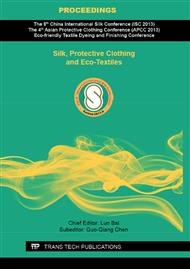[1]
F. Vollrath, Spider Webs and Silks, Sci. Am. 266(1992) 70-76.
DOI: 10.1038/scientificamerican0392-70
Google Scholar
[2]
D. A. Tirrell, Putting a New Spin on Spider Silk, Science 271(1996) 39-40.
DOI: 10.1126/science.271.5245.39
Google Scholar
[3]
O. Hakimi, D.P. Knight and F. Vollrath, et al, Spider and Mulberry Silkworm Silks as Compatible Biomaterials, Composite Part B 38(2007) 324-337.
DOI: 10.1016/j.compositesb.2006.06.012
Google Scholar
[4]
R.S. Wilsong, Control of drag-line in certain Spiders, Am. Zool 9(1969) 103–111.
Google Scholar
[5]
D.P. Knight, M.M. Knight and F. Vollrath, Beta transition and stress-induced phase separation in the spinning of spider dragline silk, Int. J. Biol. Macromol 27(2000) 205–210.
DOI: 10.1016/s0141-8130(00)00124-0
Google Scholar
[6]
P.A. Guerette, D.G. Ginzinger and B.H.F. Weber, et al, Silk properties determined by gland-specific expression of a spider fibroin gene family, Science 272(1996) 112-115.
DOI: 10.1126/science.272.5258.112
Google Scholar
[7]
C.Y. Hayashi and R.V. Lewis, Evidence from flagelliform silk cDNA for the structural basis of elasticity and modular nature of spider silks, J. Mol. Biol. 275(1998) 773-784.
DOI: 10.1006/jmbi.1997.1478
Google Scholar
[8]
J. Leclerc, T. Lefèvre and F. Pottier, et al, Structure and pH-induced alterations of recombinant and natural spider silk proteins in solution, Biopolymers 97(2012) 337-346.
DOI: 10.1002/bip.21717
Google Scholar
[9]
Q. Xu, Z.J. Pan and D.N. Qian, et al, Molecular Structure of Regenerated Spider Silk Protein, Journal of Soochow University 25(2005) 10-14.
Google Scholar
[10]
M. Zhang, Y.M. Zhang and W. Wu, et al, Preparation and characterization of spidroin and PLLA blended nanofiber mats, The 7th China International Silk Conference(2010) 122-126.
Google Scholar
[11]
E. Iizuka and J.T. Yang, Optical rotatory dispersion and circular dichroism of the beta form of silk fibroin in solutions, Proc Natl Acad Sci USA 55(1966) 1175-1182.
DOI: 10.1073/pnas.55.5.1175
Google Scholar
[12]
Y. Chen, J.T. Yang and H.M. Martinex, Determination of the secondary structures of proteins by circular dichroism and optical rotatory dispersion. Biochemistry, Biochemistry 11(1972) 4120-4131.
DOI: 10.1021/bi00772a015
Google Scholar
[13]
X.G. Li, L.Y. Wu and M.R. Huang, et al, Conformational transition and liquid crystalline state of regenerated silk fibroin in water, Biopolymers 89(2007) 497-505.
DOI: 10.1002/bip.20905
Google Scholar
[14]
X. Chen, D.P. Knight and Z.Z. Shao, et al, Conformation Transition in Silk Protein Films Monitored by Time-Resolved Fourier Transform Infrared Spectroscopy: Effect of Potassium Ions on Nephila Spidroin Films, Biochemistry 41(2002) 14944-14950.
DOI: 10.1021/bi026550m
Google Scholar


